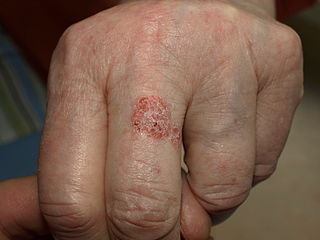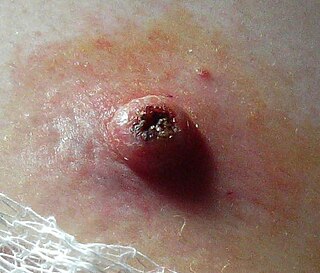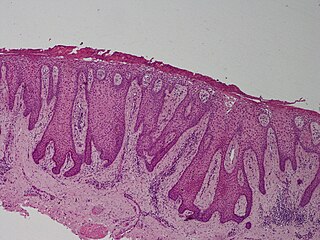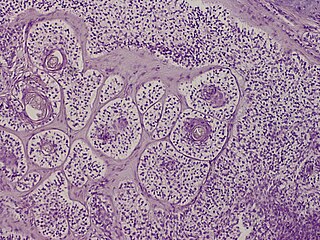| Apocrine gland carcinoma | |
|---|---|
 | |
| Apocrine gland carcinoma, papillary type | |
| Specialty | Dermatology/oncology |
Apocrine gland carcinoma is a cutaneous condition characterized by skin lesions which form in the axilla or anogenital regions. [1] :670
| Apocrine gland carcinoma | |
|---|---|
 | |
| Apocrine gland carcinoma, papillary type | |
| Specialty | Dermatology/oncology |
Apocrine gland carcinoma is a cutaneous condition characterized by skin lesions which form in the axilla or anogenital regions. [1] :670

Eccrine carcinoma is a rare cutaneous condition characterized by a plaque or nodule on the scalp, trunk, or extremities.
Primary cutaneous adenoid cystic carcinoma is a cutaneous condition characterized by a tumor that usually presents on the chest, scalp, or vulva of middle- to older-aged persons.

Bowen's disease, also known as squamous cell carcinoma in situ is a neoplastic skin disease. It can be considered as an early stage or intraepidermal form of squamous cell carcinoma. It was named after John T. Bowen.

A seborrheic keratosis is a non-cancerous (benign) skin tumour that originates from cells in the outer layer of the skin. Like liver spots, seborrheic keratoses are seen more often as people age.

Keratoacanthoma (KA) is a common low-grade rapidly-growing skin tumour that is believed to originate from the hair follicle and can resemble squamous cell carcinoma.

Nevoid basal-cell carcinoma syndrome (NBCCS), also known as basal-cell nevus syndrome, multiple basal-cell carcinoma syndrome, Gorlin syndrome, and Gorlin–Goltz syndrome, is an inherited medical condition involving defects within multiple body systems such as the skin, nervous system, eyes, endocrine system, and bones. People with this syndrome are particularly prone to developing a common and usually non-life-threatening form of non-melanoma skin cancer. About 10% of people with the condition do not develop basal-cell carcinomas (BCCs).

Cutaneous horns, also known by the Latin name cornu cutaneum, are unusual keratinous skin tumors with the appearance of horns, or sometimes of wood or coral. Formally, this is a clinical diagnosis for a "conical projection above the surface of the skin." They are usually small and localized, but can, in very rare cases be much larger. Although often benign, they can also be malignant or premalignant.
Amelanotic melanoma is a type of skin cancer in which the cells do not make any melanin. They can be pink, red, purple or of normal skin color, and are therefore difficult to diagnose correctly. They can occur anywhere on the body, just as a typical melanoma can.

Rombo syndrome is a very rare genetic disorder characterized mainly by atrophoderma vermiculatum of the face, multiple milia, telangiectases, acral erythema, peripheral vasodilation with cyanosis and a propensity to develop basal cell carcinomas. The lesions become visible in late childhood, began at ages 7 to 10 years and are most pronounced on the face, At that time a pronounced, somewhat cyanotic redness of the lips and hands was evident as well as moderate follicular atrophy of the skin on the cheeks. In adulthood, whitish-yellow, milia-like papules and telangiectatic vessels developed. The papules were present particularly on the cheeks and forehead, gradually becoming very conspicuous and dominating the clinical picture. Trichoepitheliomas were found in 1 case. In adults, the eyelashes and eyebrows were either missing or irregularly distributed with defective and maldirected growth. Basal cell carcinomas were a frequent complication. The skin atrophy was referred to as vermiculate atrophoderma. Basal cell carcinomas may develop around the age of 35. Histological observations during the early stage include irregularly distributed and atrophic hair follicles, milia, dilated dermal vessels, lack of elastin or elastin in clumps. After light irradiation a tendency to increased repair activity was observed both in epidermis and in the dermal fibroblasts. Histologic sections showed the dermis to be almost devoid of elastin in most areas with clumping of elastic material in other areas. The disorder had been transmitted through at least 4 generations with instances of male-to-male transmission.

Porokeratosis is a specific disorder of keratinization that is characterized histologically by the presence of a cornoid lamella, a thin column of closely stacked, parakeratotic cells extending through the stratum corneum with a thin or absent granular layer.
Pityriasis rotunda is a disorder of keratisation of the skin that manifests as a perfectly circular, scaly patches on the torso and proximal portions of the extremities. It may be associated with diseases like hepatocellular carcinoma in racially predisposed groups.

Clear cell acanthoma is a benign clinical and histological lesion initially described as neoplastic, which some authors now regard as a reactive dermatosis. It usually presents as a moist solitary firm, brown-red, well-circumscribed, 5 mm to 2 cm nodule or plaque on the lower extremities of middle-aged to elderly individuals The lesion has a crusted, scaly peripheral collarette and vascular puncta on the surface. It is characterized by slow growth, and may persist for years. The clinical differential diagnosis includes: dermatofibroma, inflamed seborrheic keratosis, pyogenic granuloma, basal cell carcinoma, squamous cell carcinoma, verruca vulgaris, psoriatic plaque, and melanoma.

A sebaceous adenoma, a type of adenoma, a cutaneous condition characterized by a slow-growing tumor usually presenting as a pink, flesh-coloured, or yellow papule or nodule.

Sebaceoma is a cutaneous condition that appears as a yellow or orange papule.

Trichilemmoma is a benign cutaneous neoplasm that shows differentiation toward cells of the outer root sheath. The lesion is often seen in the face and neck region. Multifocal occurrence is associated with Cowden syndrome, in which hamartomatous intestinal polyposis is seen in conjunction with multiple tricholemmoma lesions.

Trichilemmal carcinoma is a cutaneous condition reported to arise on sun-exposed areas, most commonly the face and ears.
Melanocytic oral lesions are an extremely uncommon condition characterized by pigmented lesions of the mucous membranes.
Papillomatosis cutis carcinoides is a cutaneous condition characterized by verrucous skin lesions, and is due to an HPV infection of the skin.
| This Epidermal nevi, neoplasms, cysts article is a stub. You can help Wikipedia by expanding it. |